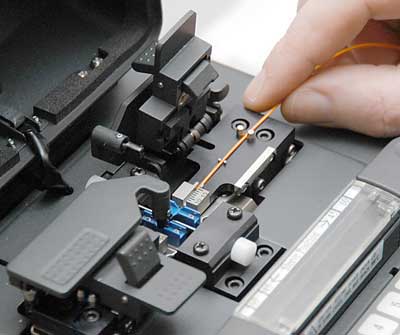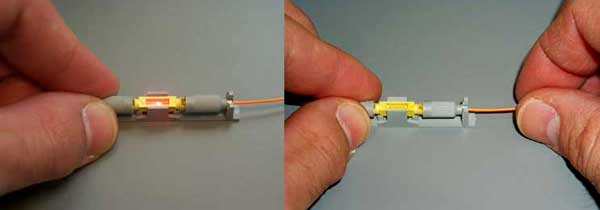It is generally accepted that splicing is often required to create a continuous optical path for optical pulses from one fiber length to another. Thus, relevant skills and knowledge of fiber optic splicing methods have become increasingly essential to any company or fiber optic technician specialized in telecommunication or LAN and networking projects. Under some circumstances, fiber optic cables may need to be spliced together to ensure better performance, such as to achieve a connection of a certain length, or just to repair a broken cable. For example, the maximum lengths of a fiber optic cable is up to about 5 km, then two fiber optic cable need to be spliced together to achieve 10km lengths of data transmission. This article aims to describe some basic elements related to optical fiber splicing thus to provide useful information about it.
What Is Fiber Optic Splicing
Just as the name indicates, fiber optic splicing serves as a method to join two optical fiber together due to some necessary reasons. Fiber optic splicing typically lead to lower light loss and back reflection than termination, making it a relatively preferred method when the transmission distances are too long for a single length of fiber or when one have to joint two different types of cable together, such as a 48-fiber cable to four 12-fiber cables. Besides, splicing is also used to restore or repair fiber optic cables when a buried cable is accidentally broken or damaged.
The Types of Fiber Optic Splicing
Basically, there exist two fiber interconnection methods: one is fusion splicing and the other is mechanical splicing. If you are just beginning to splice fiber, you might need to look at your long-term goals in this field in order to choose which technique best fits your economic and performance expectations.
Fusion splicing remains to be one of the most widely adopted permanent technique to joint optical fibers, which contains the process of fusing or welding two fibers together usually by an electric arc. The popularity of this kind of splicing method is resulted from the lowest loss and least reflection it offers. Moreover, it also provides the strongest and most reliable joint between two fibers. Fusion splicing can be achieved by a specialized equipment called fusion splicer that generally involves two functions: aligning the fibers and then melting them together.

Mechanical splicing, on the other hand, is simply aligned and designed to hold in place by a self-contained assembly. Two fibers are not permanently joined, just precisely held together to enable light to pass from one fiber into the other. Mechanical splicing are especially popular for fast, temporary restoration or for splicing multimode fibers in a premises installation. Meanwhile, they are also used as temporary splices for testing bare fibers with OTDRs or OLTSs.
Mechanical splices generally have higher loss and greater reflection than fusion splices, but they do not need an expensive machine to fulfill the splicing tasks. All needed are just a simple cleaver and some cable preparation tools. Sometimes, a visual fault locator(VFL) may help to optimize some types of splices.

The Procedures of Fiber Optic Splicing
Both of fusion splicing and mechanical splicing consist of four basic steps, and for the first two steps, these two splicing methods are relatively the same. They only differ from each other in the last two steps.
Four basic steps to achieve a proper fusion splicing:
Step 1: Preparing the fiber- Striping the protective coatings, jackets, tubes, strength members, etc. leaving only the bare fiber and keeping it clean.
Step 2: Cleaving the fiber-Using a good fiber cleaver is essential to ensure a successful fusion splice. The cleaved end must be mirror-smooth and perpendicular to the fiber axis to obtain a proper splice.
Step 3: Fusing the fiber-Two steps involves in this step: alignment and heating. Alignment can be manual or automatic depending on what equipment you have. Once properly aligned the fusion splicer unit then uses an electrical arc to melt the fibers, permanently welding the two fiber ends together.
Step 4: Protecting the fiber-Protecting the fiber from bending and tensile forces will ensure the splice not break during normal handling. A typical fusion splice has a tensile strength between 0.5 and 1.5 lbs and will not break during normal handling but it still requires protection from excessive bending and pulling forces. Using heat shrink tubing, silicone gel and/or mechanical crimp protectors will protect the splice from outside elements and breakage.
Four basic steps to complete a mechanical splicing:
Step 1: Preparing the fiber -Striping the protective coatings, jackets, tubes, strength members, etc. leaving only the bare fiber and keeping it clean.
Step 2: Cleaving the fiber-The process is identical to the cleaving for fusion splicing but the cleave precision is not as critical.
Step 3: Mechanically join the fibers-No heat is needed in this method. Simply position the fiber ends together inside the mechanical splice unit. The index matching gel inside the mechanical splice apparatus will help couple the light from one fiber end to the other. Older apparatus will have an epoxy rather than the index matching gel holding the cores together.
Step 4: Protecting the fiber-The completed mechanical splice provides its own protection for the splice.
Conclusion
From what discussed above, we can figure out that these two types of fiber optic splicing methods obtain their advantages and drawbacks. Whether to fusion splicing or mechanical splicing in fact depend greatly on several elements, such as transmission distance, signal loss and reflection requirements. For most telecommunication and CATV companies, they incline to invest in fusion splicing for their long haul single-mode network. While in terms of shorter, local cable runs, they still prefer mechanical splicing. However, since signal loss and reflection are minor concerns for most LAN applications, either of these two methods can be equally employed in the LAN industry.

No comments:
Post a Comment